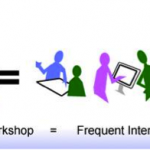1. “What Do Prototypes Protoype?” Stephen Houde and Charles Hill
Houde and Hill defined the triangle diagram of prototyping in sections of: Role, Look and Feel, and Implementation, that are later connected by integration. These sections seem to be rudimentary for any prototype, the text seems to be quite dated actually, since it was written in the 90’s and in 20 years design and its application has evolved to include more complicated social and environmental consequences. If I were to redesign their diagram I would add more sections branching off the initial point they consider. For example in the Implementation section I would add a cost, environmental impact, approximate life, etc, for the Role section: educational value, service value, comparison to existing products, and prospective problems, for the Look and Feel section: performance, portability, transformability, and social relevance.
This article touches on some important aspects of prototyping design, and it brakes down the process as if there is a recipe for prototyping. I’m not sure if I agree with then completely, since every idea is different and a bit volatile. The important aspects of functionality of a service versus an environment versus an artifact have to be approached in various ways, depending on the most salient feature of the design. Even within artifacts one can find ideas that are not concerned with the role, since the role is the look and feel in itself. For the time period Houde and Hill did an exceptional job at defining some concerns within the prototype design practice. The conclusion of the article brakes up the steps and importance of prototypes. Defining a prototype that arises the most important questions in the least amount of time, build many prototypes, know your audience, and know your prototype by explaining to the audience what purpose your prototype serves. This last step, knowing your prototype, has some problems, prototypes should be engaging and self explanatory, though the conversation between the audience and the designer about what is missing, can be key for discovering new problems.
2. “Experience Prototyping” Marion Buchenau and Jane Fulton Suri
Buchenau and Fulton Suri’s essay was the most interesting of the three essays. This article explores the role of the designer as a social investigator and as an audience themselves. The separation between the audience and the designer can blur the objective of an idea, so when designers take the role of the audience they can better perceive its problems and potential solutions. In a more philosophical sense, the designer as a creator becomes a position of power that can ultimately distort the function of design in the first place.
In “Experience Prototyping” the authors have defined a major part of design that was not explored by the previous essay “What do Prototypes Prototype?” which is experience, performance, environment, social relevance, contextual, temporal, and sensory. By acting out the natural situations in which their audience would be using their products, the designers managed to acquire a realistic perspective on the implementation necessities. Allowing the experiences around the initial role of the prototype to be the most important and first experimentation phase of design.
An important aspect of this essay is that it values experience as much as it values it’s analysis. The authors also take into account that every user’s experience will be different, so it is important to take a survey of functionality and average experience. The only thing I don’t understand about this essay is the Kiss Communicator, they could have done without it. Though, I guess it was important to show a product that was difficult to present to an audience that would not use such a device. Either way, this product should not have made it out of who ever’s head, made on to a prototype, and written about in this essay.
3. “Cardboard Computers” Pelle Ehn and Morton Kyng
I was a little disappointed with this essay. I thought they were going to describe how they made working cardboard computers, but no, they were talking about mock-ups. Ehn and Kyng describe the experience of a news team changing to adopt new printing and editing technologies. The interesting thread through this experiment, called the Utopia project, was to redesign a new working environment between journalists and typographers. The main goal was to implement a system where no one had to trample over each other’s tasks, but to have sufficient communication to collaborate in creating the best paper layouts possible.
At first they began with an office mock-up of chairs and cardboard boxes. The participants were to act out their normal work situation, in this instance the authors bring up the idea of role-playing and children’s games. Participants are to imagine that the cardboard box in front of them is a laser printer and based on this assumption they need to continue their colloquial work dialogue taking into account the new possibilities of easily printing single copies to see the actual proof. Later on they move on to acually geting computers and screens, they determine the correct size, and find that some of the mock-up become so well designed that the participants are beginning to click on paper, and so on.
In my conclusion of this essay, it was unnecessarily long, and tedious. It did not bring any new idea or good point of departure for prototyping, as a matter of fact I thing that their process was so long that it made their prototype more a hassle than useful. Marion Buchenau and Jane Fulton Suri essay “Experience Prototyping” was a much more dense and relevant study of performance, mock-ups, and play.










Comments!